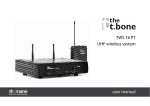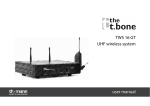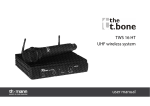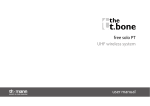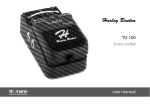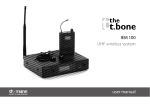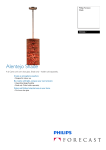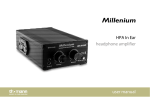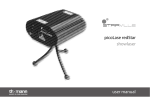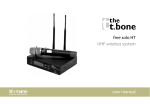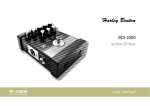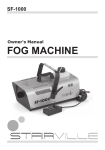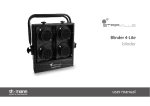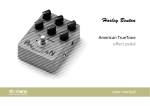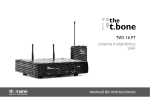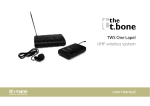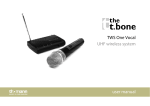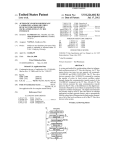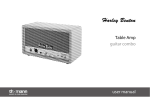Download Manual
Transcript
TWS 16 BT UHF wireless system user manual Musikhaus Thomann e.K. Treppendorf 30 96138 Burgebrach Germany Telephone: +49 (0) 9546 9223-0 email: [email protected] Internet: www.thomann.de 09.03.2012 Table of contents Table of contents 1 General notes............................................................................................................................................... 5 2 Safety instructions..................................................................................................................................... 7 3 Features and scope of delivery......................................................................................................... 11 4 Installation and starting up................................................................................................................ 4.1 General information........................................................................................................................ 4.2 Receiver............................................................................................................................................... 4.3 Transmitter......................................................................................................................................... 5 Components and functions................................................................................................................ 26 5.1 Receiver............................................................................................................................................... 26 5.2 Transmitter......................................................................................................................................... 30 6 Troubleshooting...................................................................................................................................... 33 7 Technical specifications....................................................................................................................... 7.1 Receiver............................................................................................................................................... 7.2 Transmitter......................................................................................................................................... 7.3 Frequency charts.............................................................................................................................. 17 17 19 24 35 35 37 39 TWS 16 BT 3 Table of contents 8 Protecting the environment.............................................................................................................. 45 UHF wireless system 4 General notes 1 General notes This user manual contains important information on the safe operation of the device. Read and follow all safety notes and all instructions. Save this manual for future reference. Make sure that it is available to all persons using this device. If you sell the device to another user, be sure that they also receive this manual. Our products are subject to a process of continuous development. We therefore reserve the right to make changes without notice. Symbols and signal words This section gives an overview of the symbols and signal words used in this user manual. TWS 16 BT 5 General notes Signal word Meaning DANGER! This combination of symbol and signal word indicates an immediate dangerous situation that will result in death or serious injury if it is not avoided. NOTICE! This combination of symbol and signal word indicates a possible dangerous situation that can result in material and environmental damage if it is not avoided. Warning signs Type of danger Warning – danger zone. UHF wireless system 6 Safety instructions 2 Safety instructions Intended use This device is intended to be used for the wireless transmission of audio signals from micro‐ phones or instruments to amplifiers or active speakers. Use the device only as described in this user manual. Any other use or use under other operating conditions is considered to be improper and may result in personal injury or property damage. No liability will be assumed for damages resulting from improper use. This device may be used only by persons with sufficient physical, sensorial, and intellectual abilities and having corresponding knowledge and experience. Other persons may use this device only if they are supervised or instructed by a person who is responsible for their safety. TWS 16 BT 7 Safety instructions Safety DANGER! Danger for children Ensure that plastic bags, packaging, etc. are disposed of properly and are not within reach of babies and young children. Choking hazard! Ensure that children do not detach any small parts (e.g. knobs or the like) from the unit. They could swallow the pieces and choke! Never let children unattended use electrical devices. NOTICE! Operating conditions This device has been designed for indoor use only. To prevent damage, never expose the device to any liquid or moisture. Avoid direct sunlight, heavy dirt, and strong vibrations. UHF wireless system 8 Safety instructions NOTICE! External power supply The device is powered by an external power supply. Before connecting the external power supply, ensure that the input voltage (AC outlet) matches the voltage rating of the device and that the AC outlet is protected by a residual cur‐ rent circuit breaker. Failure to do so could result in damage to the device and pos‐ sibly the user. Unplug the external power supply before electrical storms occur and when the device is unused for long periods of time to reduce the risk of electric shock or fire. NOTICE! Risk of fire due to incorrect polarity Incorrectly inserted batteries may destroy the device or the batteries. Ensure that proper polarity is observed when inserting batteries. TWS 16 BT 9 Safety instructions NOTICE! Possible damage by leaking batteries Leaking batteries can cause permanent damage to the device. Take batteries out of the device if it is not going to be used for a longer period. UHF wireless system 10 Features and scope of delivery 3 Features and scope of delivery The UHF wireless system TWS 16 BT is ideal for professional audio transmission, for example, at events, on rock stages and concert halls, in theatres and musicals, or in nightclubs. the t.bone TWS 16 BT 800 MHz (item no. 223626) Your UHF wireless system TWS 16 BT has the following components: n 9.5" diversity receiver DS16R – Adjustable squelch – Two antennas for optimum reception quality – Very high sensitivity at a very high signal-to-noise ratio – Outputs: XLR, 1/4" socket – 9.5" or 19" rack mounting (side by side with a second TWS 16 receiver) – Operating voltage supply: DC 12 V n Transmitter: Condenser clip-microphone for wind Instruments BT TWS The system operates in one of 16 switchable channels (within a range of 800.875 MHz… 811.875 MHz). Four systems can be operated simultaneously. Included accessories: 12 V power supply, hardware for rack mounting, cable with two 1/4" jacks, windscreen. TWS 16 BT 11 Features and scope of delivery the t.bone TWS 16 BT 854 MHz (item no. 223628) Your UHF wireless system TWS 16 BT has the following components: n 9.5" diversity receiver DS16R – Adjustable squelch – Two antennas for optimum reception quality – Very high sensitivity at a very high signal-to-noise ratio – Outputs: XLR, 1/4" socket – 9.5" or 19" rack mounting (side by side with a second TWS 16 receiver) – Operating voltage supply: DC 12 V n Transmitter: Condenser clip-microphone for wind Instruments BT TWS The system operates in one of 16 switchable channels (within a range of 854.375 MHz… 861.875 MHz). Four systems can be operated simultaneously. Included accessories: 12 V power supply, hardware for rack mounting, cable with two 1/4" jacks, windscreen. UHF wireless system 12 Features and scope of delivery the t.bone TWS 16 BT 863 MHz (item no. 223629) Your UHF wireless system TWS 16 BT has the following components: n 9.5" diversity receiver DS16R – Adjustable squelch – Two antennas for optimum reception quality – Very high sensitivity at a very high signal-to-noise ratio – Outputs: XLR, 1/4" socket – 9.5" or 19" rack mounting (side by side with a second TWS 16 receiver) – Operating voltage supply: DC 12 V n Transmitter: Condenser clip-microphone for wind Instruments BT TWS The system operates in one of 15 switchable channels (within a range of 863.125 MHz… 864.875 MHz). Three systems can be operated simultaneously. Included accessories: 12 V power supply, hardware for rack mounting, cable with two 1/4" jacks, windscreen. TWS 16 BT 13 Features and scope of delivery the t.bone TWS 16 BT 600 MHz (item no. 269805) Your UHF wireless system TWS 16 BT has the following components: n 9.5" diversity receiver DS16R – Adjustable squelch – Two antennas for optimum reception quality – Very high sensitivity at a very high signal-to-noise ratio – Outputs: XLR, 1/4" socket – 9.5" or 19" rack mounting (side by side with a second TWS 16 receiver) – Operating voltage supply: DC 12 V n Transmitter: Condenser clip-microphone for wind Instruments BT TWS The system operates in one of 16 switchable channels (within a range of 606.225 MHz… 629.825 MHz). This frequency range is specially intended to be used in Great Britain. Three sys‐ tems can be operated simultaneously. Included accessories: 12 V power supply, hardware for rack mounting, cable with two 1/4" jacks, windscreen. UHF wireless system 14 Features and scope of delivery the t.bone TWS 16 BT 740 MHz (item no. 269807) Your UHF wireless system TWS 16 BT has the following components: n 9.5" diversity receiver DS16R – Adjustable squelch – Two antennas for optimum reception quality – Very high sensitivity at a very high signal-to-noise ratio – Outputs: XLR, 1/4" socket – 9.5" or 19" rack mounting (side by side with a second TWS 16 receiver) – Operating voltage supply: DC 12 V n Transmitter: Condenser clip-microphone for wind Instruments BT TWS The system operates in one of 16 switchable channels (within a range of 740.625 MHz… 751.500 MHz). This frequency range is intended for use in Germany with regard to LTE. Three systems can be operated simultaneously. Included accessories: 12 V power supply, hardware for rack mounting, cable with two 1/4" jacks, windscreen. TWS 16 BT 15 Features and scope of delivery the t.bone TWS 16 BT 821 MHz (item no. 273716) Your UHF wireless system TWS 16 BT has the following components: n 9.5" diversity receiver DS16R – Adjustable squelch – Two antennas for optimum reception quality – Very high sensitivity at a very high signal-to-noise ratio – Outputs: XLR, 1/4" socket – 9.5" or 19" rack mounting (side by side with a second TWS 16 receiver) – Operating voltage supply: DC 12 V n Transmitter: Condenser clip-microphone for wind Instruments BT TWS The system operates in one of 16 switchable channels (within a range of 821.725 MHz… 831.450 MHz). Four systems can be operated simultaneously. Included accessories: 12 V power supply, hardware for rack mounting, cable with two 1/4" jacks, windscreen. UHF wireless system 16 Installation and starting up 4 Installation and starting up 4.1 General information Unpack and check carefully there is no transportation damage before using the unit. Keep the equipment packaging. To fully protect the device against vibration, dust and moisture during transportation or storage use the original packaging or your own packaging material suitable for transport or storage, respectively. Establish all connections as long as the unit is switched off. Use the shortest possible highquality cables for all connections. TWS 16 BT 17 Installation and starting up Notes on wireless transmission n This product utilizes frequencies that are not harmonized within the European Union (EU) and therefore may only be used in certain EU member states. Before you start, make sure the frequencies are allowed in the respective country. n Make sure, that transmitter and receiver are both tuned to the same channel. n Never set multiple transmitters to the same channel. n Make sure that there are no metal objects between the transmitter and receiver. n Avoid interference from other radio systems, television or radio sets. UHF wireless system 18 Installation and starting up 4.2 Receiver XLR connectors for signal output on the receiver The receiver offers a XLR mounting plug for signal output. Drawing and table indicate the XLR pin assignment (balanced). 1 Ground, shielding 2 Positive signal (+) 3 Negative signal (–) TWS 16 BT 19 Installation and starting up 1/4" phone socket for signal output on the receiver The receiver offers a 1/4" mono phone socket for signal output. Drawing and table indicate the pin assignment for a suitable TS jack. 1 Signal 2 Ground, shielding UHF wireless system 20 Installation and starting up Rack mounting This device is designed for 9.5" rack mounting, it occupies 1 rack unit. The required mounting hardware is included. Two units can be mounted side by side in a 19" rack slot. Connect both units using the sup‐ plied connecting brackets as shown in the drawing below. TWS 16 BT 21 Installation and starting up UHF wireless system 22 Installation and starting up Connecting the supply voltage NOTICE! External power supply The device is powered by an external power supply. Before connecting the external power supply, ensure that the input voltage (AC outlet) matches the voltage rating of the device and that the AC outlet is protected by a residual cur‐ rent circuit breaker. Failure to do so could result in damage to the device and pos‐ sibly the user. Unplug the external power supply before electrical storms occur and when the device is unused for long periods of time to reduce the risk of electric shock or fire. First connect the AC adaptor to the receiver and then plug the adaptor into the outlet. TWS 16 BT 23 Installation and starting up Hooking up audio connections and starting up Connect one of the audio outputs of the receiver to your mixer or amplifier. Make sure that only one of the two outputs of the receiver is used at the same time. Otherwise, interferences can by caused. First adjust the volume control (6) as follows: n If you use a microphone input of your mixer, turn the knob to about 1 o'clock. The audio level at the output sockets will be about 77 mV. n If you use a line input of your mixer, turn the knob clockwise to the right stop. The audio level at the output sockets will be about 770 mV. In order to achieve optimal sound quality, a fine adjustment may be required. 4.3 Transmitter Inserting batteries into the transmitter Open the battery compartment cover (20) by pressing the tab highlighted by ‘PUSH’ and insert the battery. Pay attention to the correct alignment of the poles. Close the battery compart‐ ment and turn on the transmitter. The LED (15) lights up briefly. UHF wireless system 24 Installation and starting up Taking the transmitter into operation n Make sure that the transmitter is switched off, so the main switch (14) is in ‘OFF’ position. n Adjust the gain with the ‘GAIN’ control (16) to a medium value. Use a suitable screwdriver. n Use the clip to attach the transmitter to your instrument. The gooseneck allows optimum positioning of the microphone. The inclination and the spring tension of the clip are adjustable so that the transmitter can be optimally adapted to the instrument. n If you notice disturbing noises by direct air flow attach the supplied windscreen on the microphone. n Turn on the transmitter and the receiver and test the transmission by playing the instru‐ ment. If necessary, adjust the gain of the transmitter (using the ‘GAIN’) and the levels on your mixer or amp. TWS 16 BT 25 Components and functions 5 Components and functions 5.1 Receiver Front panel UHF wireless system 26 Components and functions 1 POWER Main switch to turn the device on and off. 2 This indicator lights up red when the unit is turned on and operational. 3 CH Rotary control to select a channel 1 to 16. 4 AF This indicator lights up red when an audio signal is received. 5 RF LEVEL These LEDs indicate the strength of the received carrier signal. The more LEDs light up, the better is the reception. If no LED is lit no signal is received. 6 VOLUME Use this control to adjust the output level of the two audio outputs on the rear panel. TWS 16 BT 27 Components and functions Rear panel UHF wireless system 28 Components and functions 7 Tuned UHF antennas. The receiver evaluates the radio signal from both antennas and selects the signal with the highest quality for further processing. 8 AUDIO OUTPUT – BALANCED XLR mounting plug as balanced audio output for the direct connection to a mixing console, power amp, or recording device 9 AUDIO OUTPUT – UNBALANCED 1/4" phone socket as unbalanced audio output for the direct connection to a mixing console, power amp, or recording device 10 LINE/MIC Switch for adjusting the levels of the audio outputs. Select the ‘–0dBV’ position when connecting the audio output of the unit to a line level input. Select the ‘–20dB’ position when connecting the audio output to a mic level input. 11 SQUELCH Use this control to set the threshold for the squelch. Note: Setting the threshold too high will reduce the dynamic of the system. 12 DC INPUT Connect the supplied wall plug transformer to this socket. If you want to use a different power supply you have to consider the correct voltage, polarity of the plug, and the power consumption. TWS 16 BT 29 Components and functions 5.2 Transmitter 6 BT-TWS UHF TRANSMITTER 5 3 . GAIN 3 3 4 1 1 9 5 2 13 OFF 0/ . UHF wireless system 30 MUTE ON . Components and functions 13 Flexible antenna 14 ON/MUTE/OFF Main switch. Either to turn the device on and off or to mute it. 15 LOW BATT Shows the charging level of the battery. If you turn on the transmitter the LED briefly lights up and indicates that the battery supplies a sufficient voltage. If the LED is lit continuously the battery is depleted. In this case, the battery should be changed or -if applicable- recharged. 16 GAIN Rotary control to adjust the input sensitivity to the level of the input signal. 17 Adjustable clip to be connected to your instrument. 18 Gooseneck 19 CHANNEL Rotary control to select a channel 1 to 16. TWS 16 BT 31 Components and functions 20 Battery compartment for one micro battery (AAA, LR03), 1.5 V or rechargeable battery. 21 Indication of the frequency range in which the device operates. This specification must match the indication printed on the underside of the receiver. UHF wireless system 32 Troubleshooting 6 Troubleshooting Following we list a few common problems that may occur during operation. We give you some suggestions for easy troubleshooting: Symptom Remedy No sound 1. Check the operating voltage supply of transmitter and receiver. 2. Make sure that transmitter and receiver operate within the same frequency range. The respective frequency range is indicated on the units. 3. Are both transmitter and receiver set to the same channel? 4. Check the connection between the receiver and the connected audio device (amplifier, mixer). Is the connected audio device turned on and is the output level of the receiver well adjusted for the audio input device? 5. Try to improve the transmission by moving the transmitter closer to the receiver. Maybe the ‘SQUELCH’ controller is set too high. TWS 16 BT 33 Troubleshooting Symptom Remedy 6. See if any metal parts near the transmitter or receiver interfere with the trans‐ mission. Transmission is disrupted 1. Change the orientation of the antennas. 2. If you use more than one wireless system at the same time, control the fre‐ quencies and channels used. The systems should work within separate fre‐ quency ranges. 3. Also televisions, radios, or mobile phones can cause interference. Sound is distorted Change the setting of the ‘VOLUME’ controller on the receiver. If the procedures recommended above do not succeed, please contact our Service Center. You can find the contact information at www.thomann.de. UHF wireless system 34 Technical specifications 7 Technical specifications 7.1 Receiver Output XLR mounting plug, balanced 1/4" phone socket, unbalanced Carrier frequency UHF band (518…928 MHz) Modulation type Frequency modulation (FM) Oscillator PLL synthesizer, 15 or 16 channels, depending on model version Intermediate frequency 1: 243.95 MHz; 2: 10.7 MHz Frequency stability ± 0.005 % Signal-to-noise ratio > 94 dB, @ 48 kHz deviation and 60 dBµV from antenna input Normal deviation ± 20 kHz Image and spurious rejection 80 dB min. TWS 16 BT 35 Technical specifications Input sensitivity 8 dBµV Selectivity > 50 dB Pilot tone 32.768 kHz Audio frequency response 50 Hz…15 kHz (±3 dB) THD <1% Dynamic range > 96 dB Operating voltage DC 12 V Dimensions (W × D × H, w/o antennas) 210 mm × 189 mm × 50 mm Weight 515 g UHF wireless system 36 Technical specifications 7.2 Transmitter Carrier frequency UHF band (518…928 MHz) Modulation type Frequency modulation (FM) Oscillator PLL synthesizer, 15 or 16 channels, depending on model version Transmission power 10 mW max. Frequency stability ±0.005 % Normal deviation ±20 kHz Spurious emission > 60 dB below carrier frequency THD <1% Pilot tone 32.768 kHz Voltage supply 1 × micro (AAA, LR03, 1.5 V) or rechargeable battery Current draw 130 mA ±10 mA TWS 16 BT 37 Technical specifications Dimensions (W × D × H, w/o antenna and wind shield) 175 mm × 33 mm × 90 mm Width with antenna 245 mm Weight (w/o batteries) 56 g UHF wireless system 38 Technical specifications 7.3 Frequency charts the t.bone TWS 16 BT 800 MHz (item no. 223626) Channel Frequency (MHz) Channel Frequency (MHz) 1 800.875 9 806.625 2 801.375 10 807.375 3 802.375 11 807.875 4 803.125 12 808.375 5 803.875 13 809.125 6 804.500 14 810.250 7 805.125 15 810.875 8 805.875 16 811.875 TWS 16 BT 39 Technical specifications the t.bone TWS 16 BT 854 MHz (item no. 223628) Channel Frequency (MHz) Channel Frequency (MHz) 1 854.375 9 858.500 2 854.875 10 858.875 3 855.500 11 859.375 4 855.875 12 860.125 5 856.500 13 860.750 6 857.125 14 861.250 7 857.750 15 861.500 8 858.125 16 861.875 UHF wireless system 40 Technical specifications the t.bone TWS 16 BT 863 MHz (item no. 223629) Channel Frequency (MHz) Channel Frequency (MHz) 1 863.125 9 863.250 2 863.375 10 863.500 3 863.625 11 863.750 4 864.000 12 864.125 5 864.250 13 864.375 6 864.500 14 864.625 7 864.750 15 864.875 8 864.875 TWS 16 BT 41 Technical specifications the t.bone TWS 16 BT 600 MHz (item no. 269805) Channel Frequency (MHz) Channel Frequency (MHz) 1 606.225 9 619.625 2 607.225 10 621.225 3 609.625 11 621.625 4 610.225 12 624.825 5 611.025 13 625.425 6 611.625 14 627.225 7 615.025 15 628.625 8 619.225 16 629.825 UHF wireless system 42 Technical specifications the t.bone TWS 16 BT 740 MHz (item no. 269807) Channel Frequency (MHz) Channel Frequency (MHz) 1 740.625 9 746.625 2 741.375 10 747.250 3 742.375 11 747.875 4 743.125 12 748.500 5 743.750 13 749.375 6 744.375 14 750.125 7 745.250 15 750.875 8 745.875 16 751.500 TWS 16 BT 43 Technical specifications the t.bone TWS 16 BT 821 MHz (item no. 273716) Channel Frequency (MHz) Channel Frequency (MHz) 1 821.725 9 827.300 2 822.250 10 827.825 3 822.925 11 828.525 4 823.375 12 828.925 5 823.950 13 829.475 6 824.850 14 829.875 7 825.450 15 830.975 8 826.525 16 831.450 UHF wireless system 44 Protecting the environment 8 Protecting the environment Disposal of the packaging mate‐ rial For the transport and protective packaging, environmentally friendly materials have been chosen that can be supplied to normal recycling. Ensure that plastic bags, packaging, etc. are properly disposed of. Do not just dispose these materials with your normal household waste, but make sure that they are fed to a recovery. Please follow the notes and markings on the packaging. Disposal of your old device This device is subject to the European directive 2002/96/EC. Do not dispose the device with your normal household waste. Dispose this device through an approved waste disposal firm or through your local waste facility. When discarding the device, comply with the rules and regulations that apply in your country. If in doubt, consult your local waste disposal facility. TWS 16 BT 45 Protecting the environment Disposal of batteries Batteries must not be disposed of as domestic waste or thrown into fire. Dispose of the bat‐ teries according to national or local regulations regarding hazardous waste. To protect the environment, dispose of empty batteries at your retail store or at appropriate collection sites. UHF wireless system 46 Musikhaus Thomann e.K. · Treppendorf 30 · 96138 Burgebrach · Germany · www.thomann.de
















































